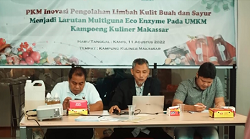Pembuatan dan Pemanfaatan Larutan Multiguna Eco Enzyme sebagai Upaya Reduksi Limbah Organik di Kampoeng Kuliner Makassar Production and Aplication of Eco Enzyme Multipurpose Solutions as an Effort for Organic Waste Reduction of Kampoeng Kuliner Makassar
Main Article Content
Abstract
Kampoeng Kuliner Makassar (KKM) is one of the MSMEs in the culinary field in Makassar. KKM produces about 25 kg/day of organic waste, mainly fruit and vegetable. This community partnership program is a form of transfer of knowledge and technology fermentation in organic waste treatment, which aims to assist KKM partners in processing fruit and vegetable peel waste into eco-enzyme which is then used as a multipurpose cleaning solution according to KKM needs. This activity consists of a focus discussion group (FGD), counseling, making and harvesting eco enzyme, and its application in the restaurant as a multipurpose cleaning solution. Paired t-test results of participants' pre-test and post-test showed a significant increase (p-value < 0.001) in participants' knowledge about various aspects of eco-enzyme. The participants' skills are improved through independent practice so that all participants can produce good quality eco enzymes. Eco-enzyme has been used as a cleaning and disinfection agent, such as washing agents for food, tableware, and cooking utensils; kitchen and bathroom cleaners at KKM. After this community partnership program, it is hoped that KKM can become a place to promote a healthy lifestyle with minimal waste.
Downloads
Article Details

This work is licensed under a Creative Commons Attribution-ShareAlike 4.0 International License.
Authors who publish with this journal agree to the following terms:
- Any article on the copyright is retained by the author(s).
- Author grant the journal, right of first publication with the work simultaneously licensed under a Creative Commons Attribution License that allows others to share work with acknowledgment of the work authors and initial publications in this journal.
- Authors are able to enter into a separate, additional contractual arrangements for non-exclusive distribution of published articles of work (eg, post-institutional repository) or publish it in a book, with acknowledgment of its initial publication in this journal.
- Authors are permitted and encouraged to post their work online (e.g., in institutional repositories or on their websites) prior to and during the submission process, as can lead to productive exchanges, as well as earlier and greater citation of published work.
- The article and any associated published material is distributed under the Creative Commons Attribution-ShareAlike 4.0 International License
References
Arun, C., & Sivashanmugam, P. (2015). Investigation of biocatalytic potential of garbage enzyme and its influence on stabilization of industrial waste activated sludge. Process Safety and Environmental Protection, 94, 471-478. https://doi.org/10.1016/j.psep.2014.10.008
Aswan, D. T. (2018). Chocolicious Company Akan Launching Kampung Kuliner. https://makassar.tribunnews.com/2018/11/19/chocoliciouscompany-akan-launching-kampung-kuliner-ada-1000-coto-gratis
Barman, I., Hazarika, S., Gogoi, J., & Talukdar, N. (2022). A Systematic Review on Enzyme Extraction from Organic Wastes and its Application. Journal of Biochemical Technology, 13, 32–37. https://doi.org/10.51847/JVfUPnKi16
Chin, Y. Y., Goeting, R., Alas, Y., & Shivanand, P. (2018). From fruit waste to enzymes. Scientia Bruneiana, 17(2), 1-12. https://doi.org/10.46537/scibru.v17i2.75
Hasanah, Y. (2021). Eco enzyme and its benefits for organic rice production and disinfectant. Journal of Saintech Transfer, 3(2), 119–128. https://doi.org/10.32734/jst.v3i2.4519
Ismoyo, C., Muluk, M. K., & Saleh, C. (2015). Peningkatan Partisipasi Masyarakat dalam Pengelolaan Sampah Rumah Tangga. Reformasi : Jurnal Ilmiah Ilmu Sosial dan Ilmu Politik, 5(1), 75–88. https://doi.org/10.33366/rfr.v5i1.65
Lou, L. I. T. (2017). The Material Culture of Green Living in Hong Kong. Anthropology Now, 9(1), 70–79. http://dx.doi.org/10.1080/19428200.2017.1291055
Maharani, S. E., & Dewi, N. L. P. M. (2022). Implementasi Pengomposan Dan Eco Enzyme Dalam Pengolahan Sampah Rumah Tangga Di Kelurahan Abianbase. Jurnal Ecocentrism, 2(2), 30-42.
Muliarta, I. N., & Darmawan, I. K. (2021). Processing Household Organic Waste into Eco-Enzyme as an Effort to Realize Zero Waste. Agriwar Journal, 1(1), 6–11.
Putra, G. M. (2021). Konsep Zero Waste Skala Rumah Tangga Lingkungan Perumahan. Pelita Kota Journal, 2(2), 46-54. https://doi.org/10.51742/pelita.v2i2.417
Rusdianasari, Syakdani, A., Zaman, M., Sari, F. F., Nasyta, N. P., & Amalia, R. (2021a). Utilization of Eco-Enzymes from Fruit Skin Waste as Hand Sanitizer. AJARCDE (Asian Journal of Applied Research for Community Development and Empowerment), 5(3), 23-27. https://doi.org/10.29165/ajarcde.v5i3.72
Rusdianasari, Syakdani, A., Zaman, M., Sari, F. F., Nasyta, N. P., & Amalia, R. (2021b). Production of Disinfectant by Utilizing Eco-enzyme from Fruit Peels Waste. International Journal of Research in Vocational Studies (IJRVOCAS), 1(3), 1–7. https://doi.org/10.53893/ijrvocas.v1i3.53
Sunarsih, E. (2014). Konsep Pengolahan Limbah Rumah Tangga dalam Upaya Pencegahan Pencemaran Lingkungan. Jurnal Ilmu Kesehatan Masyarakat, 5(3), 162-167.
Sundari, D., Almasyhuri, & Lamid, A. (2015). Pengaruh Proses Pemasakan Terhadap Komposisi Zat Gizi Bahan Pangan Sumber Protein. Media Penelitian dan Pengembangan Kesehatan, 25(4), 235-242. http://dx.doi.org/10.22435/mpk.v25i4.4590.235-242
Vama, L., & Cherekar, M., N. (2020). Production, extraction and uses of eco-enzyme using citrus fruit waste: Wealth from waste. Asian Journal of Microbiology, Biotechnology & Environmental Sciences, 22(2), 346–351.
Wulansari, D., Ekayani, M., & Karlinasari, L. (2019). Kajian Timbulan Sampah Makanan Warung Makan. ECOTROPHIC : Jurnal Ilmu Lingkungan (Journal of Environmental Science), 13(2), 125-134. https://doi.org/10.24843/EJES.2019.v13.i02.p01
